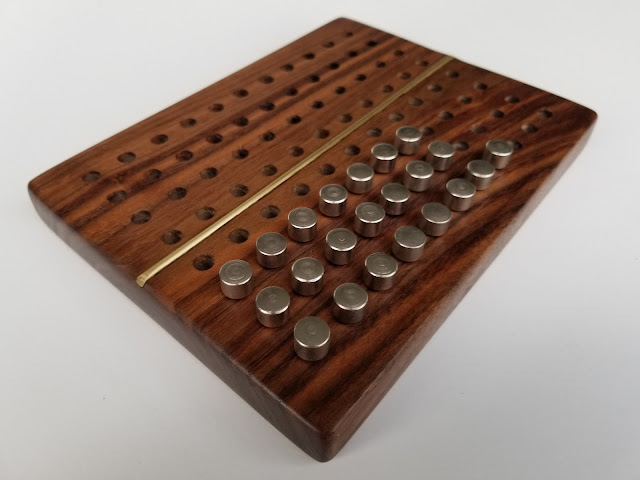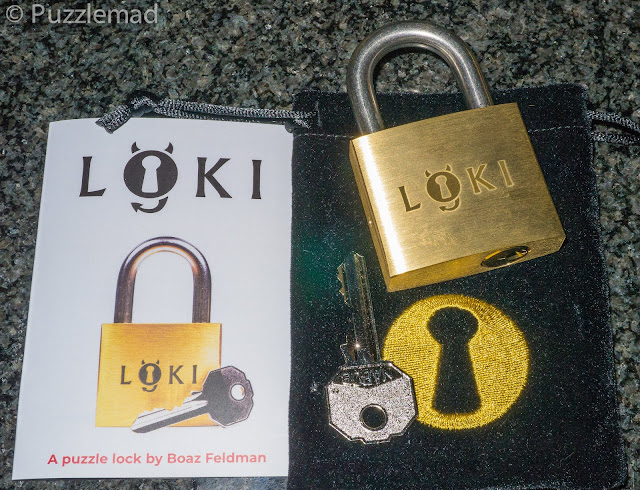Happy Sunday everyone! I have been rather strapped for time yet again - work has
been very busy both with clinical stuff and quite a lot of admin too. I had to
work yesterday and have not really had any time for puzzling. Despite this,
thanks to my good friend, Mike Desilets, the official PuzzleMad foreign
correspondent, I still have a fascinating post for you. I don't know how he does
it, Mike always seems to sense when I am struggling for time and comes up with
the goods for me/you. This time he did it in the guise of asking for some help
with a puzzle he had been struggling with but I know that he is too good a
puzzler to need help and it is just an excuse to get in touch with yet another
article. I hope to get back to normal puzzling this week (although I am working
next weekend as well) - if anyone else has a nice article for the PuzzleMad
readers then please
get in touch. Over to Mike...
Aloha kākou puzzlers,
I know we have yet to close out the story of the Great 13, but let’s please
forget about that for a while longer. Instead, the PuzzleMad Foreign Office,
Hawaii Branch, offers up this quick and dirty post, designed specifically to
provide Kevin with a free weekend (Ed - yay!). Free from blog posting,
that is to say, not free from his actual day job, which does not respect
weekends. He deserves so much more, but this is all I can muster at the
moment. Today I share with you some recent output from the PuzzleMad Workshop,
which is conveniently located in a sub-basement 200 feet below the current Mrs
S’s house. (Ed - how come I don't have access to this area? It would definitely solve
my storage issues)

|
|
John Horton Conway (1937-2020)
|
Years ago,
George Bell
turned me on to a very interesting problem known as
Conway’s Soldiers. This problem was first proposed in 1961 by the eminent mathematician
John Horton Conway. John has, tragically, left the room, having been one of the very early covid
victims. But he left behind a massive legacy in a variety of fields. The
Conway’s Soldiers problem, or puzzle, is surely among the mildest of Conway’s
accomplishments. If you’re not familiar with John Conway’s varied contributions
to mathematics, go check the wiki right now. They’re quite remarkable. And,
unlike the great majority of mathematics (and mathematicians), also interesting,
relevant, and accessible to the average fellow, at least in broad strokes. Most
puzzlers probably know Conway from his combinatorial game theory work, of which
Conway’s Soldiers is a small piece.
Disentanglers might be familiar with his knot theory work. Everyone is
surely aware of his
Game of Life (Ed - I programmed this into my school Tandy TRS80 in 1979 and even learned
Assembly language because the Basic was too slow). If you hadn’t kept pace with his recent work, Kevin, then I highly
recommend checking out his (and Simon Kochen’s)
Free Will theorem
and its implications for the ever dubious, but somehow inextinguishable,
deterministic worldview. I actually thought that whole thing was put to bed
decades ago, but I suppose people are still free to choose determinism (or are
they?). Anyway, the point is that you will benefit greatly, and in unexpected
ways, from engaging with Conway’s vast and varied body of work.

|
|
Conway’s Soldiers, the mechanical puzzle.
|
For my part, being a simple puzzler, I was drawn especially to Conway’s Soldiers
and its peg solitaire aspects. A couple years ago, in a flash of brilliance, I
realized that creating a physical version of this abstract puzzle was within my
ability. It is truly the simplest of designs, consisting of gridded peg holes
and a line dividing the plane. A full year and a half after the initial
inspiration, I made the puzzle. The lag was partly due to the location of the
PuzzleMad Workshop, which is not convenient for me (or Mrs. S, for that
matter). (
Ed - I NEED to know how to get there - it will allow me to make puzzles and
even get a 3D printer!)
Conway’s Soldiers poses a simple question: Using conventional (but
non-diagonal) peg jumping rules, how far above the “line” can you get your
pegs? No amount of trial will ever prove an answer, of course, so in terms of
a mechanical puzzle, it is not really a “solvable” problem. The question can
only be answered (proved) mathematically, and Conway did this, showing that
the fourth row is the maximum possible. His proof utilizes the golden ratio,
by the way, which is fascinating in itself. It was later shown that allowing
diagonal moves will get you as far as the eighth row. There are numerous web
pages about the puzzle where you can study previous work and variations. You
need to read the 2007 article by George Bell and his colleagues Daniel
Hirschberg and Pablo Guerrero-Garcia,
The Minimum Size Required of a Solitaire Army. Bell et al. solve a problem that actually does make a good puzzling
objective: what is the minimum number of pegs needed to achieve a given row?

|
Look at those rings Kevin!
(Ed - drool! That is some beautiful wood)
|
Although not rigorous, you can kind of work this out yourself on the board. The
trivial row 1 and 2 arrangements are shown below, mostly as an excuse to insert
more pictures of my pretty game board. But I won’t give the solution to rows 3
or 4; you’ll have to read Bell et. al. or do the experimental work to figure
those out. You can, however, assume that the number of pegs needed to achieve
row four is equal to or less than the number peg holes on either side of my
board (
Ed - OMG - that looks quite a tough challenge).

|
|
Solution for row 1, requiring two soldiers.
|
|

|
|
Solution for row 2, requiring four soldiers.
|
|
As you can probably guess, the PuzzleMad board is made from American Black
Walnut and the pegs were scavenged from an old Setko puzzle. It is fairly simple
to construct, just drill a grid of evenly spaced holes and insert a dividing
line. Drilling the grid was tedious but straightforward. The line, in this case,
is an inlaid half-rod of brass. Inlaying it was actually very tricky and
stressful, but it did turn out well in the end. I learned in the process that
you can use a drill press as a rudimentary router. I was afraid this might
overly stress the bit, but it was actually a really smooth cut. Overall, a nice
little DIY project for the amateur puzzle-maker. (
Ed - sob! One day I will make some puzzles...probably after I have retired)

|
| In perspective. |
John Conway has left us with a very enjoyable little diversion in the Conway’s
Soldiers puzzle. Even if you cannot follow his fourth-row proof, you can surely
figure out, eventually, how to arrange and sequence your army to achieve it. You
can also, if you like, dwell on the more philosophical “diminishing returns”
aspect of this problem. I think most people would intuitively believe that any
level above the line is achievable, given enough soldiers, but the truth is that
there is a hard theoretical limit, and that limit is surprisingly low
indeed.
That's about all I can muster for this mini-post Kevin, please take us home my
friend...
My goodness! Thank you so much Mike. That was wonderful! You have given me
(us) a nice bit of enjoyable reading to do and anything involving JHC and also
George bell is always fun! I absolutely love the beauty of your home made
constructions (even if they were apparently made under my home - I was totally
unaware that I even had a basement).
Mrs S has had her booster yesterday and is feeling quite poorly - I had better
go and offer her something sweet and sustaining as well as maybe some
paracetamol or ibuprofen. Be careful out there everyone. Go and get your
booster shots. The evidence seems to be that Omicron is significantly more
transmissible and even if it tends to cause slightly less severe illness
overall (we don't actually know that for certain yet) then by sheer numbers, a
lot of unvaccinated people are going to end up in hospital or even dead. In
our hospitals, the ONLY Covid admissions are the unvaccinated or the
immunocompromised. The current vaccines with booster DO protect against severe
illness. A Covid death is a very unpleasant way to die - go and get yourself
immunised and help protect your health services as well as the vulnerable and
yourselves.
Whilst you are here, there is a
Kickstarter campaign
being run by the PuzzleMaster guys: They are crowdfunding the production of
three fabulous looking new metal puzzles. The skull is a design by Jerry Loo and
consists of 67 interlocking pieces - it looks incredible! The other two puzzles
are level 9 and 10 on the PuzzleMaster scale and also look fun. This will
run until New Years Day and certainly looks worth your attention - I have backed
it (backer number 25).

|
| Mind the gap |
Also, my friend Andrew Coles, has created another puzzle lock, the "
Mind the gap" puzzle. It will be available to order from his
site quite soon. I have received my copy and hope to play soon.
I have had no luck yet solving
Boaz Feldman's latest
creation -
Loki, and
suspect that locks are too difficult for me!










Bravo, Mike! That is a beautiful board! Now maybe you can make one on a hexagonal grid? That is more difficult, and you'd need a larger board, and more pegs!
ReplyDeletehttp://www.gibell.net/pegsolitaire/army/SolitaireRegiments_Level7_156Pegs_ForwardS.gif
ReplyDeleteI'm on it George, thanks! (might take a while...)
ReplyDeleteWow! I’m now looking forward to the next article in the series on peg solitaire variants! Thank you so much guys.
Delete